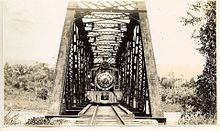Northern Railroad of Guatemala
| Guatemala Northern Railway | |||
|---|---|---|---|

Bridge over Motagua River, c. 1940.
|
|||
| Overview | |||
| Status | Closed to public | ||
| Connecting lines |
|
||
| Operation | |||
| Opened | 1896 | ||
|
|||
The Northern Railroad of Guatemala was a railway system that ran from Guatemala City to Puerto Barrios, the main port of Guatemala between 1896 and 1968, when the American United Fruit Company had the monopoly of the railway system thru its affiliate, International Railways of Central America, along with the docks at Puerto Barrios, the banana plantations in Izabal and the cargo and passenger transport with its Great White Fleet. The system was highly efficient, but once a parallel highway was built, it could not compete and eventually was handed back to the State of Guatemala in 1968. After that, the system start to slowly lose its relevance, as the trucks were more profitable than railway transportation. It ceased regular operations in 1996, and has remained partially abandoned since.
In 1883, then president general Justo Rufino Barrios had the plan to connect Guatemala City to a port in the Atlantic shore through a railroad in order to be able to move the coffee produced by his own haciendas and those of his liberal partners; therefore, on 4 August 1883, he issued a decree in which a person with a salary of more than 4 pesos a month could pay 4 pesos a year over a 10-year span to finance the railroad. However, after the untimely death of Barrios in the Battle of Chalchuapa in 1885, this plan was forgotten by his successor, general Manuel Lisandro Barillas.
It was not until in 1892, when José María Reyna Barrios assumed power, that the railroad project was started once again. On 19 July 1895, Reina Barrios issued the executive action #513, which established that, between the Escondido and Estrecho rivers, a city was to be founded, and that it was going to be called Puerto Barrios. The ceremonial act of foundation took place on 5 December 1892. Furthermore, a part of the Northern Railroad project, the executive action #524 declared Puerto Barrios as "Major port of the Republic" and ordered to transfer over there the customs that used to be in Livingston.
Given that in those days most visitors arriving from Europe and North America arrived at the port on the Caribbean Sea shore, Reina Barrios pushed for the Northern Railroad to be finished on time. Not only was the railroad vital for the Expo success, it was key to transport merchandise and passengers between the Caribbean Sea and the new Port of Iztapa on the Pacific shore of the country. Reina Barrios had high hopes on the railroad to improve the progress and development of the country given that the United States and Spain were still at war over Cuba, and it was evident that a dependable interoceanic communication line was crucial for the North American country. Completing a transoceanic railway was a main objective of Reina Barrios government, with a goal to attract international investors at a time when the Panama Canal was not built yet. However, a sharp decline in the price of coffee and silver, along with the high technical difficulties of the railroad construction close to Guatemala City −mainly due to the steep cliffs and mountain sides around the city− resulted in the collapse of Guatemala's economy, a failure of the Exposición Centroamericana and the eventual murder of president Reina Barrios, on 8 February 1898.
...
Wikipedia

